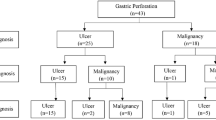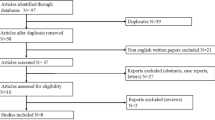Abstract
Background
The spontaneous perforation of gastric cancer is a rare fatal complication, occurring in 1% of patients with gastric cancer, and it has a wide hospital mortality range (0–82%). In addition, it has been reported that about 10–16% of all gastric perforations are caused by gastric carcinoma. The aim of this study is to evaluate the gastric perforations and improve an alternative pathway for the management of this disorder when a pathologist is not available.
Material and methods
We reviewed the medical records of 513 patients who had undergone surgical treatment for gastric perforation due to gastric ulcus or gastric carcinoma in two medical centers. Sixty-seven (13.06%) patients were treated for perforated gastric carcinoma. Perforations due to trauma and iatrogenic causes were excluded. The clinicopathologic features of all patients were analyzed on the basis of their medical records.
Results
According to the results of our analysis, we can suggest that if a patient with gastric perforation has an age more than 60 years, an ulcus diameter (with edema) more than 6 cm, a perforation diameter more than 0.5 cm, a symptom duration of more than 20 h, and a white blood cell count less than 15.103/μL, he might have a gastric carcinoma. This system has a specificity of 98.7%, a sensitivity of 53.7%, a negative predicted value of 93.4%, and positive predicted value of 85.7%.
Conclusion
The diagnosis of malignancy is often made only on postoperative or operative frozen pathologic examination. We suggest a new pathway for the gastric perforations, if a pathologist is not available during the operation.

Similar content being viewed by others
References
Ozmen MM, Zulfikaroglu B, Kece C, Aslar AK, Ozalp N, Koc M (2002) Factors influencing mortality in spontaneous gastric tumour perforations. J Int Med Res 30:180–184
Adachi Y, Mori M, Maehara Y, Matsumata T, Okudaira Y, Sugimachi K (1997) Surgical results of perforated gastric carcinoma: an analysis of 155 Japanese patients. Am J Gastroenterol 92(3):516–518
Kasakura Y, Ajani JA, Fujii M, Mochizuki F, Takayama T (2002) Management of perforated gastric carcinoma: a report of 16 cases and review of world literature. Am Surg 68:434–440
Roviello F, Rossi S, Marrelli D, De Manzoni D, Pedrazzani C, Morgagni P, Corso G, Pinto E (2006) Perforated gastric carcinoma: a report of 10 cases and review of the literature. World J Surg Oncol 4:19
Lehnert T, Buhl K, Dueck M, Hinz U, Herfarth C (2000) Two-stage radical gastrectomy for perforated gastric cancer. Eur J Surg Oncol 26:780–784
Kitakado Y, Tanigawa N, Muraoka R (1997) A case report of perforated early gastric cancer. Nippon Geka Hokan 66:86–90
Bonenkamp JJ, Songun I, Hermans J, van de Velde CJ (1996) Prognostic value of positive cytology findings from abdominal washing in patients with gastric cancer. Br J Surg 83:672–674
Wu CC, Chen JT, Chang MC, Ho WL, Chen CY, Yeh DC, Liu TJ, P’eng FK (1997) Optimal surgical strategy for potentially curable serosa-involved gastric carcinoma with intraperitoneal cancer cells. J Am Coll Surg 184:611–617
Adachi Y, Aramaki M, Shiraishi N, Shimoda K, Yasuda K, Kitano S (1998) Long-term survival after perforation of advanced gastric cancer: case report and review of the literature. Gastric Cancer 1:80–83
Cuschieri A, Weeden S, Fielding J, Bancewicz J, Craven J, Joypaul V, Sydes M, Fayers P (1999) Patient survival after D1 and D2 resections for gastric cancer: long term results of the UK MRC randomised surgical trial. Br J Cancer 79:1522–1530
Bonenkamp JJ, Hermans J, Sasako M, van de Velde CJ (1999) Extended lymph-node dissection for gastric cancer. N Engl J Med 340:908–914
Kirshtein B, Bayme M, Mayer T, Lantsberg L, Avinoach E, Mizrahi S (2005) Laparoscopic treatment of gastroduodenal perforations: comparison with conventional surgery. Surg Endosc 19:1487–1490
Author information
Authors and Affiliations
Corresponding author
Rights and permissions
About this article
Cite this article
Ergul, E., Gozetlik, E.O. Emergency spontaneous gastric perforations: ulcus versus cancer. Langenbecks Arch Surg 394, 643–646 (2009). https://doi.org/10.1007/s00423-008-0331-5
Received:
Accepted:
Published:
Issue Date:
DOI: https://doi.org/10.1007/s00423-008-0331-5




